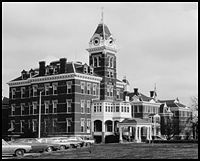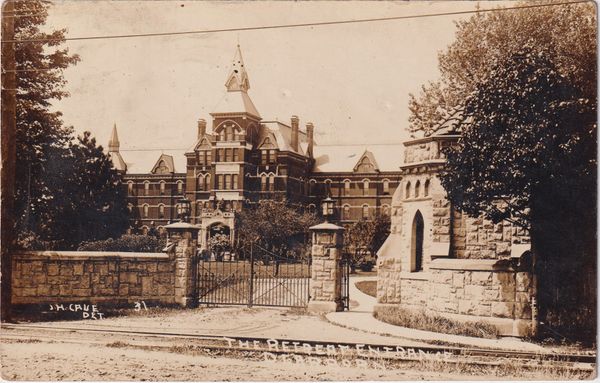Main Page
__NOTITLE__
|
We need your help!
|
| Overview · Editing · Help · How To Upload Images |
Mission Statement
The Mission
The mission of this site is to archive both historical and current information on asylums across the United States and around the world.
The Statement
This site is dedicated to the history of asylums in all forms. The term of asylum is applied to not only what is commonly thought of: mental hospitals, but can also be applied to sanatoriums, state training schools, reform schools, almshouses, and orphanages. These institutions have and continue to play a major part in today's society.
Everyone throughout the United States and in many other countries has in one way or another felt the touch of these institutions. These places have both directly and indirectly affected people and their families. They have shaped lives and created many popular myths about them.
With all that in mind, this site was created to help in the historical research of any institutions that can be classified as an asylum. It was created for both serious researchers, those who are doing genealogical research, and people with an interest in asylums.
Featured Article Of The WeekIonia State HospitalThe building of the Ionia State Hospital was authorized in 1883 and was opened under the name of the Michigan Asylum for Insane Criminals in 1885. It was found that this name was objectionable as not all of the patients in the hospital were criminals, so the name was changed by legislative action to Ionia State Hospital. The patients committed to this hospital were insane felons, criminal sexual psychopaths, insane convicts from other prisons, patients transferred from other state institutions that had developed dangerous or homicidal tendencies and persons charged with a crime but acquitted on the grounds of insanity. Initially the hospital patients were housed at the site of the Michigan Reformatory. The hospital was called the North Branch and the farm located on Riverside Drive was called the South Branch. When a large fire broke out at the hospital, all of the rooms were needed to house prisoners, so all of the hospital patients were sent to the South Branch farm. Since that time, the hospital has been located on the grounds of the Riverside Correctional Facility. The hospital was used to treat the mentally ill as well as the criminally insane until 1972, when civilians were removed from the hospital. In 1977, the Legislature transferred the operation to the Department of Corrections when it began operation as a correctional facility. The facility was closed with the reopening of the Michigan Reformatory. Click here for more... |
Featured Image Of The WeekThe St. Joseph's Retreat was established in 1860 as the Michigan State Retreat. This was Michigan's first private mental institution, and allegedly catered mostly to the affluent. It was started by the Daughters of Charity of St. Vincent de Paul. In 1855 the Sisters of St. Mary's Hospital began to care for the mentally ill, who had formerly been confined to prisons or the county poor house. In 1860, they opened a seperate facility named the Michigan State Retreat, which was incorporated in 1883 as St. Joseph's Retreat. The original building stood on 140 acres overlooking the Rouge River. It was later enlarged to house 400 patients. At first these were Civil War veterans, and later alcoholics, drug addicts, and other "incurables." The first telephone installed in Dearborn was at the Retreat in 1889.
|
Featured Video
Recent Message Board Posts
In this space you normally would see our forum. This had been a hold over from earlier days before we had a Facebook page. Just prior to our server issues regular users had been barely using the forum with the majority of new posts from anonymous users asking genealogy questions or spammers. The old forum software does not work with our new version while the new forum software does not carry over old comments to the new forum. As a result, the forum will be discontinued in favor of our Facebook page. If you have questions or comments you can ask them there.
Asylum Projects Facebook Page
If you have genealogical question here is an information page to help you.
Upcoming Events Calendar
<calendar name="Upcoming Events" disablestyles disableaddevent/>
Asylum News (news you can edit!)
February 7, 2016 Clarinda struggles to fill former hospital
- The 128-year-old former mental health institute in the small southwest Iowa city of Clarinda isn’t your typical real estate opportunity, and so far no one is rushing to move in. More than seven months after the state closed the Clarinda Mental Health Institute, much of the sprawling building remains empty, including entire floors that haven’t been used in decades.
February 1, 2016 Efforts continue to preserve other parts of former Peoria State Hospital grounds
- Christina Morris happily remembers Sunday morning breakfasts with her grandparents, followed by visits to the peaceful cemeteries on the grounds of the Peoria State Hospital, where some family members are buried. “My interest with the state hospital started when I was about 7 years old,” Morris said in a recent interview. “When I would come onto the grounds (my grandfather) would say that this was a place of special people. (By special) I thought he meant giants, because these buildings were so big and beautiful and immaculate to me. I just was enamored by how beautiful it was.”
January 7, 2016 That Time The United States Sterilized 60,000 Of Its Citizens
- Not too long ago, more than 60,000 people were sterilized in the United States based on eugenic laws. Most of these operations were performed before the 1960s in institutions for the so-called “mentally ill” or “mentally deficient.” In the early 20th century across the country, medical superintendents, legislators, and social reformers affiliated with an emerging eugenics movement joined forces to put sterilization laws on the books.
January, 6, 2016 Pa. hires firm to develop plan for Harrisburg State Hospital site
- Harrisburg, PA-The state has hired a Lancaster planning company to help it figure out what to do with the former Harrisburg State Hospital, which closed 10 years ago. Since closing in 2006, the hospital complex has housed state workers from the state police, Department of General Services and the Department of Human Services. It is now part of the larger DGS Annex property, which encompasses 303 acres across Harrisburg and Susquehanna Township.

